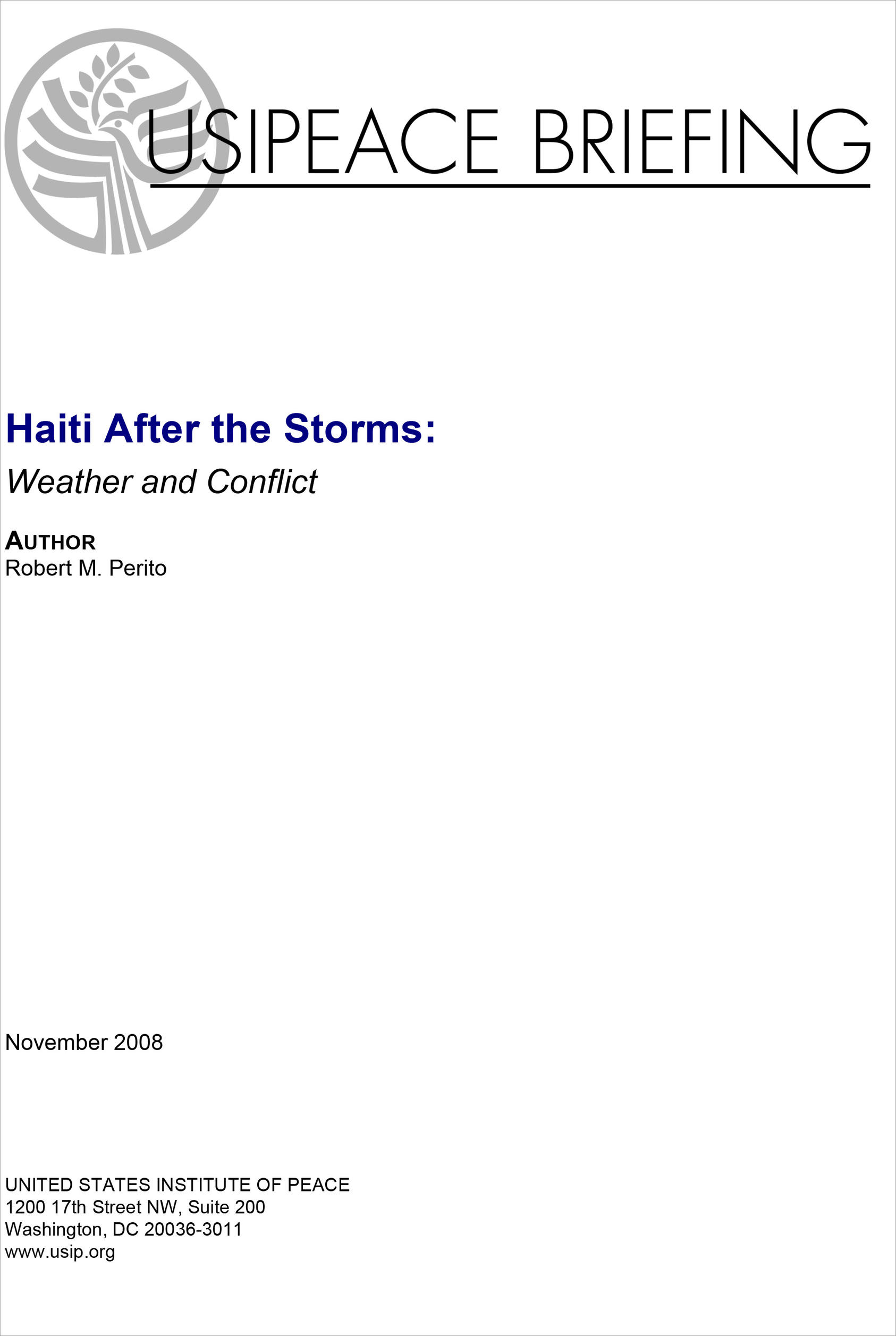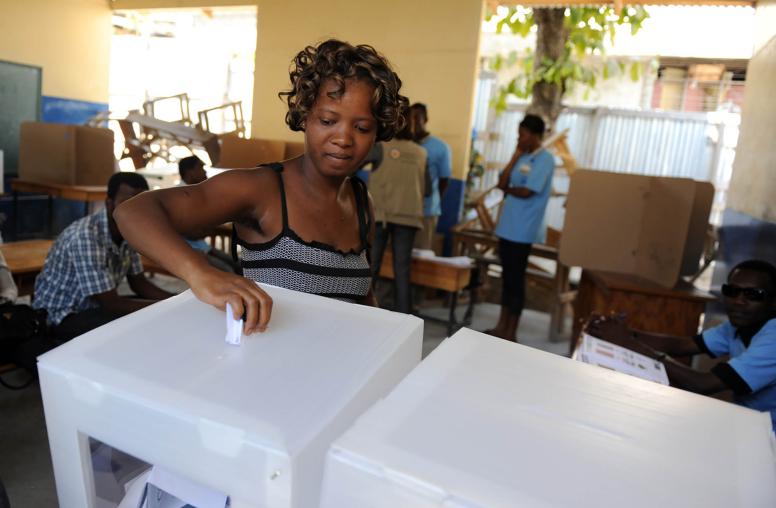Haiti After the Storms: Weather and Conflict
In September 2008, four hurricanes and tropical storms—Fay, Gustav, Hannah and Ike—slammed into Haiti with devastating force. Nearly 800 people were killed, 300 remain missing and more than 500 were injured.

In September 2008, four hurricanes and tropical storms—Fay, Gustav, Hannah and Ike—slammed into Haiti with devastating force. Nearly 800 people were killed, 300 remain missing and more than 500 were injured. More than 150,000 people were displaced. Cities and towns were inundated with mud. Roads, bridges, crops and factories were destroyed. Damage to infrastructure was so great that helicopters and boats were required to reach parts of the island. Millions were left at risk of starvation. International aid officials warned that shortages could spark the kind of food riots that erupted in April of this year.
The impact of the storms reversed a period of steady economic progress. Haiti’s President, Rene Préval, told the U.N. General Assembly that the storms set Haiti’s economy back several years. Following a survey of the damage, World Bank President Robert Zoellick concluded that Haiti was at “a tipping point.” An editorial in the Miami Herald warned that as a result of the storms, Haiti could “fall into a bottomless pit of hunger, disease, crime, poverty and desperation that would make the preceding decade of poverty, violence and instability look benign in comparison.”
The challenge facing Haiti and the international response to the crisis was discussed by a panel of distinguished experts at a recent meeting sponsored by the Institute’s Haiti Working Group. Principal speakers included:
- Yvonne Tsikata, country director for Caribbean Affairs at the World Bank
- Joseph Tilghman, country officer for Haiti at the Department of State
- Robert Maguire, USIP Jennings Randolph fellow
An Unprecedented Reconstruction Challenge

A woman walks through a neighborhood destroyed by floods in Gonaives, Haiti, Wednesday, Sept. 17, 2008. (AP Photo)
A joint assessment conducted by the World Bank, the U.N. and the European Union concluded that total losses from the storms could equal 15 percent of Haiti’s gross national product—making it the largest disaster in a century. A few statistics sketch out the extent of the destruction. One third of Haiti’s rice crop, which is the main source for domestic food consumption, plus livestock, seeds and farm equipment were destroyed. The storms occurred during the harvest, which means there will be no reserves or seeds for the coming year. Haiti’s second most politically important city, Gonaives, was primarily affected. Major portions of the city remain buried in mud and at least 80 percent of the city’s population was left homeless. Since many of the displaced were forced to seek shelter in school buildings, many schools have been unable to reopen, thereby delaying the start of the school year. Housing, which was already inadequate, took a direct hit with nearly 23,000 homes destroyed and more than 84,000 damaged. There is little prospect for replacement or repair in the near term.
The storms struck at the end of a difficult six-month period. In April 2008, rising international prices for food and fuel resulted in a spike in the cost of living in Haiti that sent protesters into the streets in several cities. U.N. security forces fired into mobs that looted stores and set fire to vehicles and public buildings. Five Haitians and one U.N. peacekeeper were killed in the violence. Following the disturbances, Haiti’s Prime Minister, Jacques-Edouard Alexis, received a no-confidence vote in parliament, plunging the country into a political crisis. Two nominees for prime minister were then rejected by the parliament before the new prime minister, Michele Pierre-Louis, was approved with a hurricane literally bearing down on the island. She will now have to manage the recovery and reconstruction process as well as address the country’s chronic problems.
International Response: Helpful But Missing the Mark
After the storms, the U.N., the World Bank, donor countries, NGOs, the Haitian diaspora and local governments and private citizens in the U.S. contributed recovery assistance. The U.N. issued a formal appeal for $108 million. The World Bank offered $25 million in additional aid. The U.S. delivered $31 million in storm-related assistance, including medical supplies, plastic sheeting, kitchen utensils and other emergency needs. The helicopter carrier USS Kearsarge used its helicopters and landing craft to ferry 3.3 million pounds of food, water, and relief supplies, plus medical personnel to hard-hit and otherwise inaccessible communities. Actor Brad Pitt and rock star Wyclef Jean gave benefit concerts. School boards in Broward County and other south Florida districts made well-publicized offers of mobile classrooms to enable the reopening of schools where buildings were destroyed or used as homeless shelters. Congress included $100 million in hurricane relief for the Caribbean in the Consolidated Security, Disaster Assistance and Continuing Appropriations Act. It is expected that nearly all of this amount ($97 million) will go to Haiti.
At the same time, critics charged that the level of international response was inadequate for the up to $1.2 billion needed for overall recovery and reconstruction. The amount given also fell short in comparison to the assistance provided to other areas that experienced similar disasters. By comparison, following the Asian Tsunami and Hurricane Mitch in Central America, long-term, multi-billion dollar assistance programs were established to ensure full recovery. Even the U.N.’s relatively restrained request for emergency aid has been partially subscribed. On October 27, 2008, John Holmes, U.N. under-secretary general for humanitarian affairs and emergency relief coordinator, announced that only $45 million had been pledged in response to the U.N.’s total assistance request of $108 million. After touring impacted areas in Haiti, he issued an urgent appeal for donors to do more, noting that six weeks remained in this year’s hurricane season.
On Capital Hill, members of Congress with a longstanding interest in Haiti urged additional steps to boost the country’s economy. Members of the Congressional Black Caucus (CBC) and representatives from southern Florida called upon the administration to grant Temporary Protected Status (TPS) to Haitians currently residing in the U.S. This would allow Haitians to remain in the U.S. and to work legally with the expectation that they would send remittances back to Haiti. The administration immediately suspended deportation of Haitians after the storms, but has been unwilling to grant TPS out of fear that it would create a magnet for illegal Haitian migration.
The question of Haiti’s debts was a related issue. CBC members called upon the U.S. and the international financial institutions (IFIs) to forgive all of Haiti’s $1.7 billion in international debt. Concerning IFIs, Haiti is in the final stages of the World Bank/IMF Heavily Indebted Poor Countries Initiative (HIPC), but is not expected to reach completion until mid-2009. Haiti is scheduled to repay over $50 million annually to multinational institutions, plus a much smaller amount in bilateral debt service. IFI representatives have noted that Haiti is on track to complete the HIPC process and the amount of debt repayment is manageable given the overall level of donor assistance.
Finally, Congressional representatives expressed hope that textile manufactures will respond to the investment incentives contained in the Haitian Hemispheric Opportunity through Partnership Encouragement (HOPE) Act that provides trade preferences for Haiti. Initial assessments are that HOPE I (adopted in 2007) created from 5,000 to 7,000 new jobs in the Haitian textile industry, but exports totaled less than ten percent of the volume allowed by the law. HOPE II, passed this year, contains expanded incentives that it is anticipated will promote new investment and additional job creation.
Haitian Responses are a Step Forward, but a “Game-Changer” is Needed
Haiti’s government took a number of critical steps as the storms approached and in their aftermath. Prior to the storms, the country’s Office for Disaster Preparedness issued warnings over radio and television that were credited with reducing the casualties relative to previous years. The Civilian Protection Unit of the Ministry of Interior prioritized needs and managed distribution of some relief supplies. The Finance Ministry waived import regulations and customs duties on relief shipments. These were encouraging signs that disaster preparedness works and that Haiti’s government has become increasingly self-reliant and responsible. After the storms, Préval spoke at the U.N. and visited Florida to champion an ambitious plan to upgrade Haiti’s infrastructure and environment to effectively withstand future storms. He called for the rerouting of rivers around Gonaives and other coastal cities, dredging harbors, building sewers and drainage networks, massive reforesting and constructing flood-resistant roads and bridges. These steps would end the annual cycle of storm damage and emergency relief that leaves Haiti equally vulnerable for the next hurricane season.
Préval’s appeal struck a responsive cord. There is talk in New York and Washington about a “game changing initiative” for Haiti that would provide the relatively large amounts of funding and the management and engineering skills required. This may involve convening a long delayed donors meeting to discuss moving beyond recovery to poverty reduction efforts such as increasing agricultural production. These conversations are in the formative stages, but international observers have been encouraged that Haiti does not want to be viewed as a victim, but seeks to move forward. Haitians appear intent on getting on with their lives, rebuilding and improving their future. There was a general feeling among those attending the working group that Haiti’s most valuable resource is the spirit of its people and that their efforts should be supported.
This USIPeace Briefing was written by Robert Perito, a senior program officer in the Center for Post-Conflict Peace and Stability Operations at the United States Institute of Peace. The views expressed here are not necessarily those of USIP, which does not advocate specific policies.
The United States Institute of Peace is an independent, nonpartisan institution established and funded by Congress. Its goals are to help prevent and resolve violent international conflicts, promote post-conflict stability and development, and increase conflict management capacity, tools, and intellectual capital worldwide. The Institute does this by empowering others with knowledge, skills, and resources, as well as by directly engaging in peacebuilding efforts around the globe.


